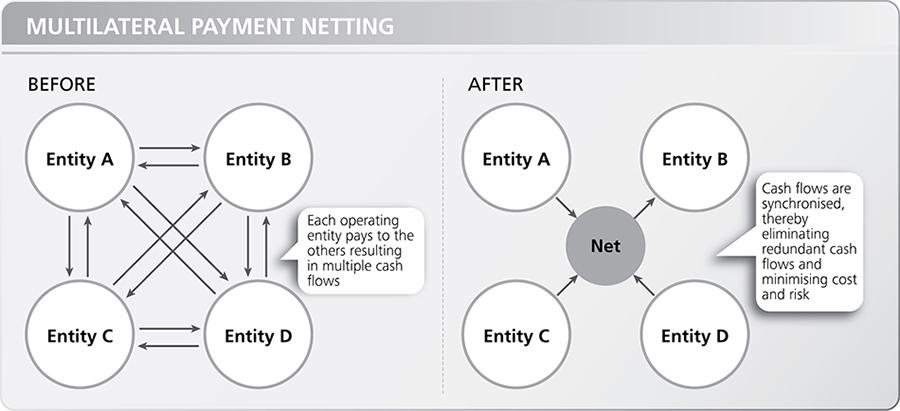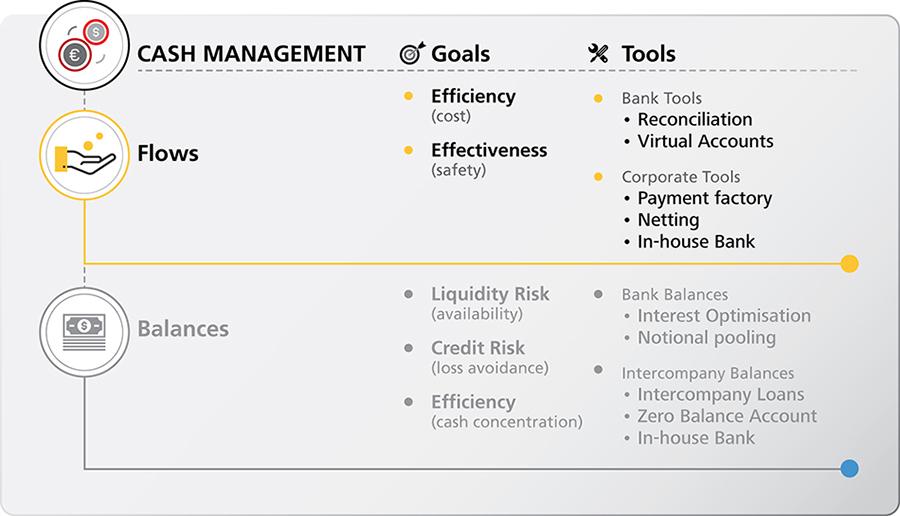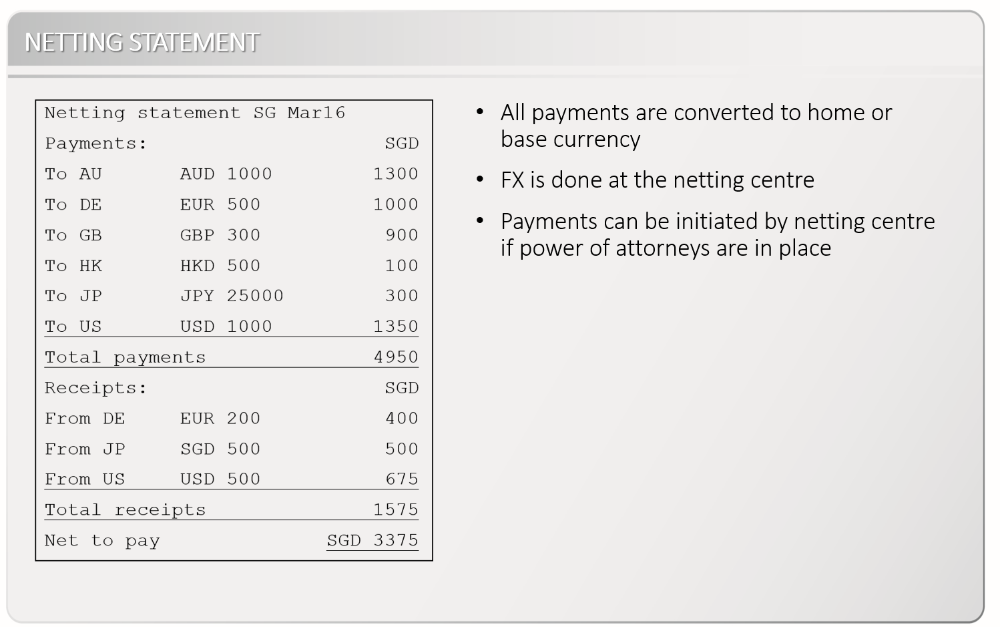Multilateral Payment Netting
Netting is a tool that helps treasurers reduce costs and operational risks managing intercompany payments. Most MNCs have substantial intercompany payments between operating entities across their supply chain for product, services, royalties, recharges, etc. When such payments are executed through banking systems, the group suffers unnecessary costs in terms of bank fees, foreign exchange spreads, and lost float. Such payments cause unnecessary operational risk of fraud and error.

What is Netting?
Netting is not a new concept. Corporates have been using netting for over 50 years, and the practice is common in finance and other industries. Examples include:
- Low value net settlement clearing systems like ACH
- Credit card systems use net settlement
- Airlines use netting to settle code shares etc.
- Telecoms uses netting to settle international call charges
The effect of corporate intercompany payment netting is to reduce the intercompany payments to one per month. Netting achieves this by standardising a common intercompany settlement date for each month, and then settling intercompany obligations through a designated netting centre, often a treasury centre or SSC or head office.

Netting compared
Netting is a flow tool implemented by corporates, rather than a bank service.

Netting improves control over and efficiency of intercompany payments. Payment factory improves control over and efficiency of vendor payments. In practice, there is some overlap – most netting systems can handle third party payments which means they can be used as payment factories, and most payment factory solution can do intercompany payment netting.
Compared to IHB, netting is payment netting whereas IHB is balance netting. IHB achieves all the benefits of both payment factory and netting, although using somewhat different methodology. IHB also improves other aspects of cash management.
Variants of Multilateral Payment Netting
Early netting systems worked on the basis of payments. Operating entities send the intercompany payments that they want to make to the netting centre, who then calculate the base currency net positions and coordinate the payments.
In the days before single instance ERPs, intercompany reconciliation was a material problem for many MNCs. To address this, netting systems adapted to process intercompany invoices rather than payments. When each operating entity sends their intercompany invoices to the netting centre, then the netting centre can perform a reconciliation of intercompany invoices before calculating the base currency net positions and coordinating settlement.
In some MNCs, intercompany settlement discipline may be lacking. When operating entities advise their payments, they can withhold funds. Netting systems adapted by allowing receivable driven netting rather than payable driven netting. Under receivable driven netting, operating entities advise what they expect to receive from others rather than what they want to pay.
An alternative to receivable driven netting is to make a policy that all intercompany invoices due in the current month must be paid in that netting cycle, regardless of whether they have been cleared or not. The thinking is that it is cleaner to pay everything invoiced and minimise intercompany outstandings, and that the relative cost of handling any errors with credit notes the following month is small.
Some operating entities may sell and/or purchase in foreign currencies. In such cases, and in the absence of centralised foreign exchange risk management, they may have material balances and/or shortfalls in foreign currencies. To help with this, netting systems evolved a mechanism to allow operating entities to request currency ('currency ask') or pay in currency ('currency offer'). In this way, operating entities are able to benefit from the economies of scale and reduced spreads offered by the netting centre, as well as reduce operational risk associated with decentralised foreign exchange dealing.
When the netting centre calculates the operating entities’ base currency net positions and coordinates the netting value date settlements at the same foreign exchange rate which they obtained from their banks, there is no gain for the netting centre and the netting centre end of day balances will be zero. Some netting centres cover their operating costs by putting a small buy/sell spread on their foreign exchange rates. Netting systems have evolved to handle this requirement.
Where an MNC has multiple operating entities in one country, there is an opportunity to net on-shore first so that there will be only one cross-border payment. Netting systems facilitate this with netting pools within the overall netting process.
When MNCs see how efficient and safe netting is, they often progress to wanting similar benefits for their third party payments. Netting systems evolve to handle third party payments, and this makes them in effect payment factories.
Process
Typically, under netting, intercompany settlement happens once a month. Third party payments often happen weekly.
The netting value date varies between MNCs, but typically it is towards the end of the month and avoids Fridays so that any errors do not result in overdrafts over the weekends. MNCs who use 4-4-5 quarters often put their netting value date to the Wednesday before month end to maximise the amount of settlements cleared before the closing of the books.
The timeline below is indicative, and based on invoice based payable netting. This timeline can be compressed considerably, especially with ERP to netting integration.
- Tuesday is reporting day. Operating entities send their intercompany invoices payable that are due in the current month to the netting centre.
- Thursday is confirmation day. This is a final check. Netting centre reconciles invoices, calculates indicative net positions for all operating entities at current market rates, and advises operating entities accordingly.
- Monday is dealing day. Netting centre executes foreign exchange deals with banks to cover the group’s net foreign exchange positions, recalculates each operating entity’s net position at dealt rates, and sends out final netting statements to each operating entity with payment instructions.
- Wednesday is settlement day. All net payments are executed with value Wednesday. Banks accounts are reconciled to ensure that all payments have gone through.

Regulations and Tax
The main regulatory issue with netting is that it has the effect that the netting centre is paying or receiving all intercompany counterparty flows on-behalf-of the operating entities. This can be worked around in various ways to preserve the process benefits of netting – normally by having the netting centre provide central bank reporting to satisfy the regulators.
Some countries do not allow net settlement. Netting systems have developed the concept of 'gross-in / gross-out' to cover this need. Instead of a single net settlement, there are two flows – one into and one out of the country. This preserves almost all of the operational and cost benefits of netting while complying with local regulations.
Exchange controls may complicate the netting process but with proper preparation operating entities in controlled markets can still participate in netting. There is, however, a greater risk of payment delays, because banks in regulated countries tend to steal float from their corporate clients, so it is preferable to use relationship banks who do not do this.
There are no substantial tax issues with netting. If the netting centre makes a service charge or charges a foreign exchange spread to the operating entities, there might possibly be a transfer pricing or BEPS issue, but the amount is likely to be immaterial.
Implementation
Netting is a lightweight tool that can be rolled out country by country across a group. It does not require any change to banking arrangements, so netting can be rolled out purely internally.
Netting generates substantial savings to groups with large intercompany invoicing, and it makes an easy first step towards payment factory and eventually IHB.
Simple payment netting can in theory be run on Excel, however for control and security reasons as well as for process efficiency, it is much better to use a netting system. Most ERPs and TMSs offer netting solutions, and there are cheap SaaS netting systems available.
The information herein is published by DBS Bank Ltd. (“DBS Bank”) and is for information only.
All case studies provided, and figures and amounts stated, are for illustration purposes only and shall not bind DBS Group. DBS Group does not act as an adviser and assumes no fiduciary responsibility or liability for any consequences, financial or otherwise, arising from any reliance on the information contained herein. In order to build your own independent analysis of any transaction and its consequences, you should consult your own independent financial, accounting, tax, legal or other competent professional advisors as you deem appropriate to ensure that any assessment you make is suitable for you in light of your own financial, accounting, tax, and legal constraints and objectives without relying in any way on DBS Group or any position which DBS Group might have expressed herein.
The information is not directed to, or intended for distribution to or use by, any person or entity who is a citizen or resident of or located in any locality, state, country or other jurisdiction where such distribution, publication, availability or use would be contrary to law or regulation.
DBS Bank Ltd. All rights reserved. All services are subject to applicable laws and regulations and service terms. Not all products and services are available in all geographic areas. Eligibility for particular products and services is subject to final determination by DBS Bank Ltd and/or its affiliates/subsidiaries.
